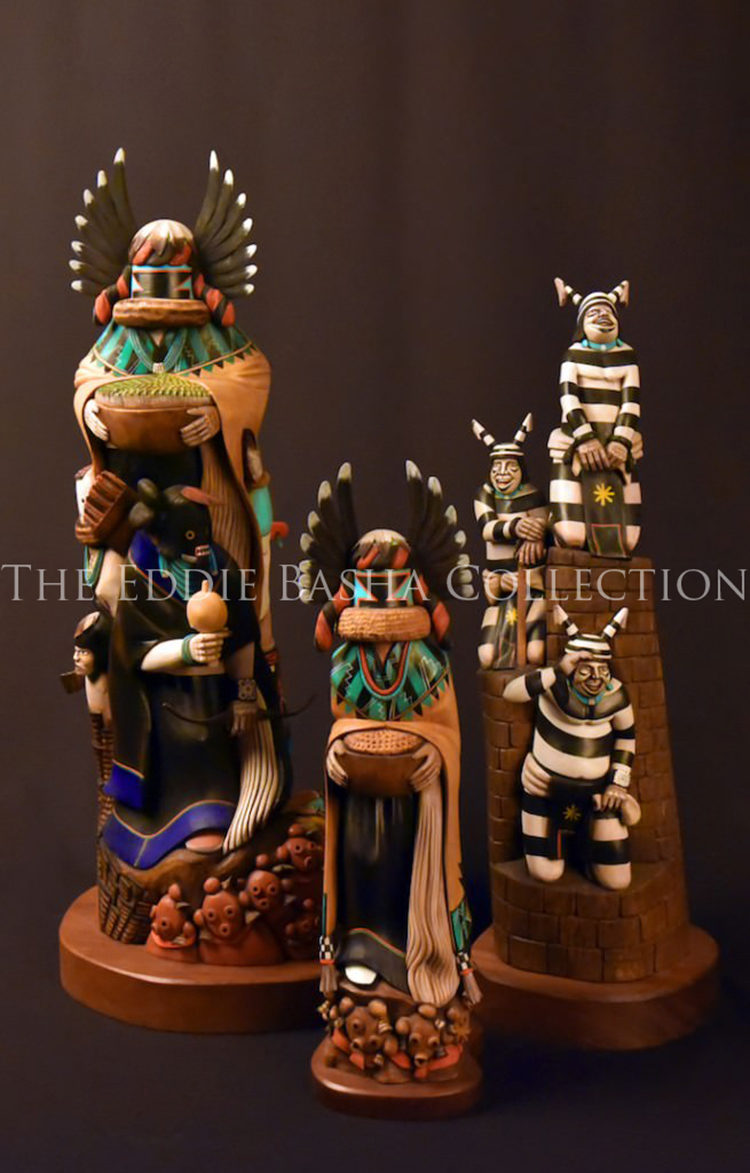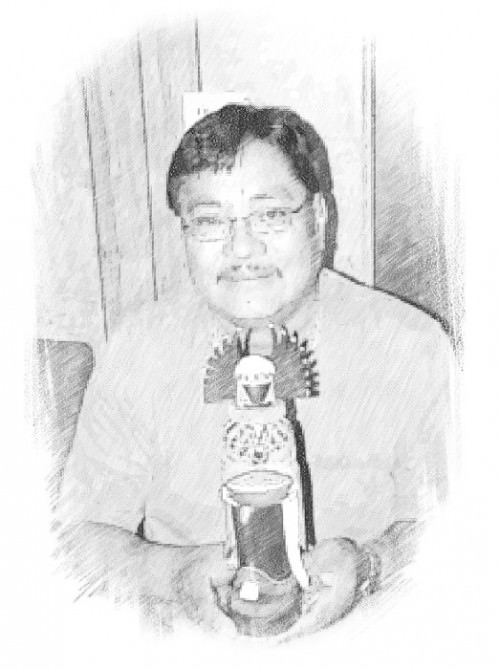
Wilmer Kaye
(b.1952)
Wilmer Kaye is a highly reputed katsina carver, one of the most recognizable names in that category of Indian art, and a veteran award-winner. He is known for the perfection of his carvings, which he has been doing since his teens. One of his uncles was the legendary Hopi jewelry artist, Charles Loloma.
Using only a pocket knife for his carving, Wilmer works on only one figure at a time, unlike some other carvers. The katsinas are embellished with paint and/or stain, and finally rubbed with linseed oil, to protect the wood and bring out the grain.
Source: Wright’s Gallery

Bean Dance Katsina
Artist: Wilmer Kaye (b.1952)
Description: Cottonwood Tree Root (1996) | Dimensions: 30”h x 12”w x 12”dkatsina
February is the Hopi lunar month of Powamuya in which one of the most important cultural events occurs, the sixteen-day Bean Dance Ceremonial. Kiva-germinated bean sprouts are distributed to villagers throughout by participating katsinam. And though the Ogre katsina threaten the children for misbehavior, they do so in a humorous way; gifts are also handed out to them.
This Bean Dance Katsina is an expressive representation of the activities and participants of this all important ceremony. It was exhibited by the artist, Wilmer Kaye, at the 1996 Santa Fe Indian Market and purchased by Eddie Basha for the collection at that time.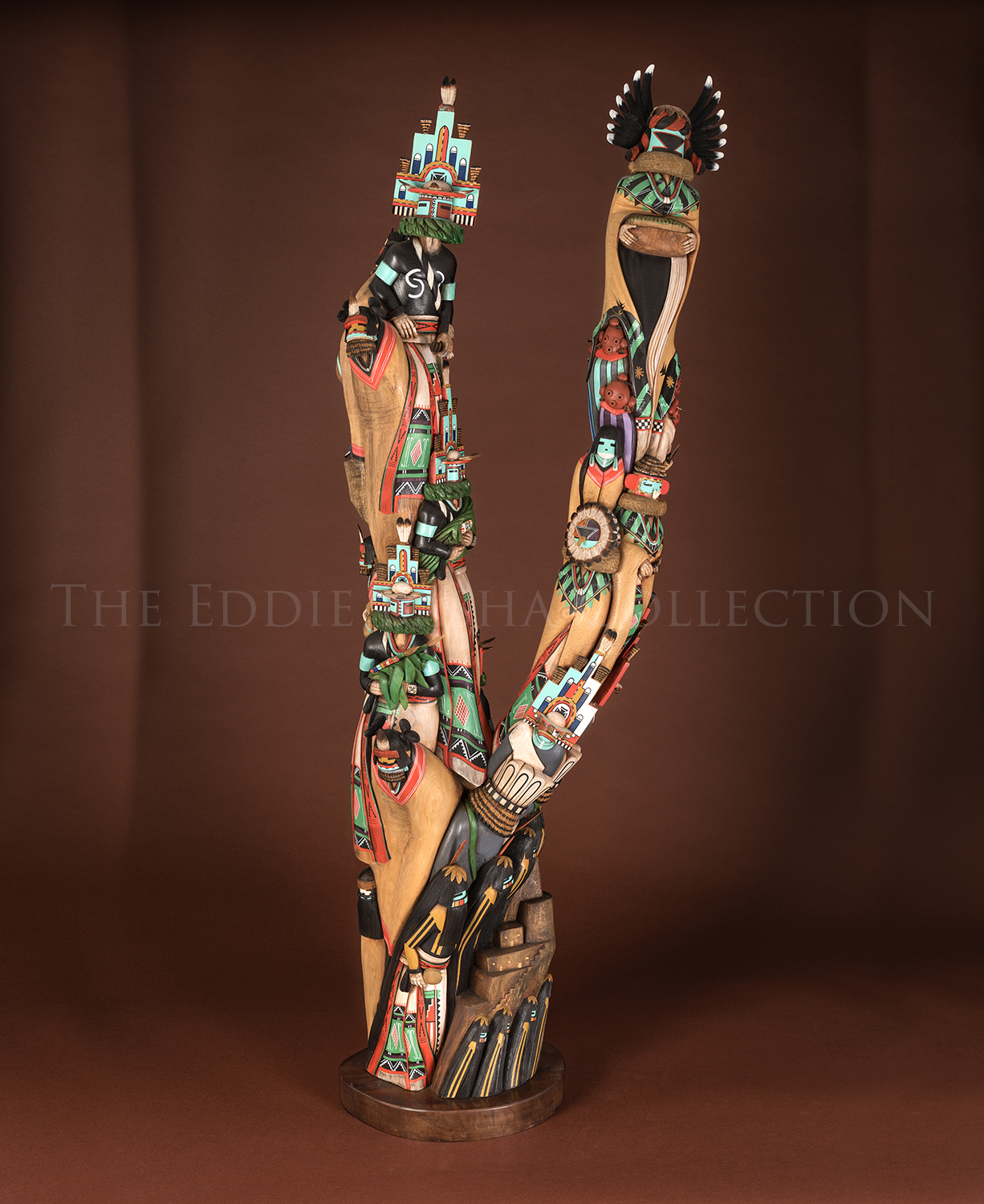
Salako & Crow Mother
Artist: Wilmer Kaye (b.1952)
Description: Cottonwood Tree Root (1995) | Dimensions: 55”h x 20”w x 17”dkatsina
Wilmer Kaye is well known for carving more sculptural dolls rather than fully detailed ones such as the one revealed here. Standing 55” tall and carved from the root of the cottonwood tree, this 1995 Best of Show Santa Fe Indian Market award winner, “Salako and Crow Mother,” with thirty-nine katsinas is a harmonious dance of grace, elegance and sophistication. Katsinam appear to rise from the kiva at the base and culminate with Salako, the Hopi Cloud Man, and Crow Mother, a figure of great dignity, two of the most beautiful and best known of all Hopi katsinas, at its two peaks. And between there are Mudheads, Long Hairs, Hano Manas, and more.
At thirteen years old, Wilmer’s apprenticeship began while watching his uncle Willard Loloma and others carve. After high school, Willard worked construction while he perfected his craft. Nowadays, he’s up with the sun and frequently spends his entire day carving. Throughout his career, Wilmer has won numerous honors and awards and has contributed to the advancement of katsina doll carving into the upper echelons of fine art. And he has done so in the good company of other talented, celebrated and award-winning relatives such as his sister, Verma Nequatewa, “Sonwai,” and their uncle, Charles Loloma, two of the most innovative Hopi jewelers.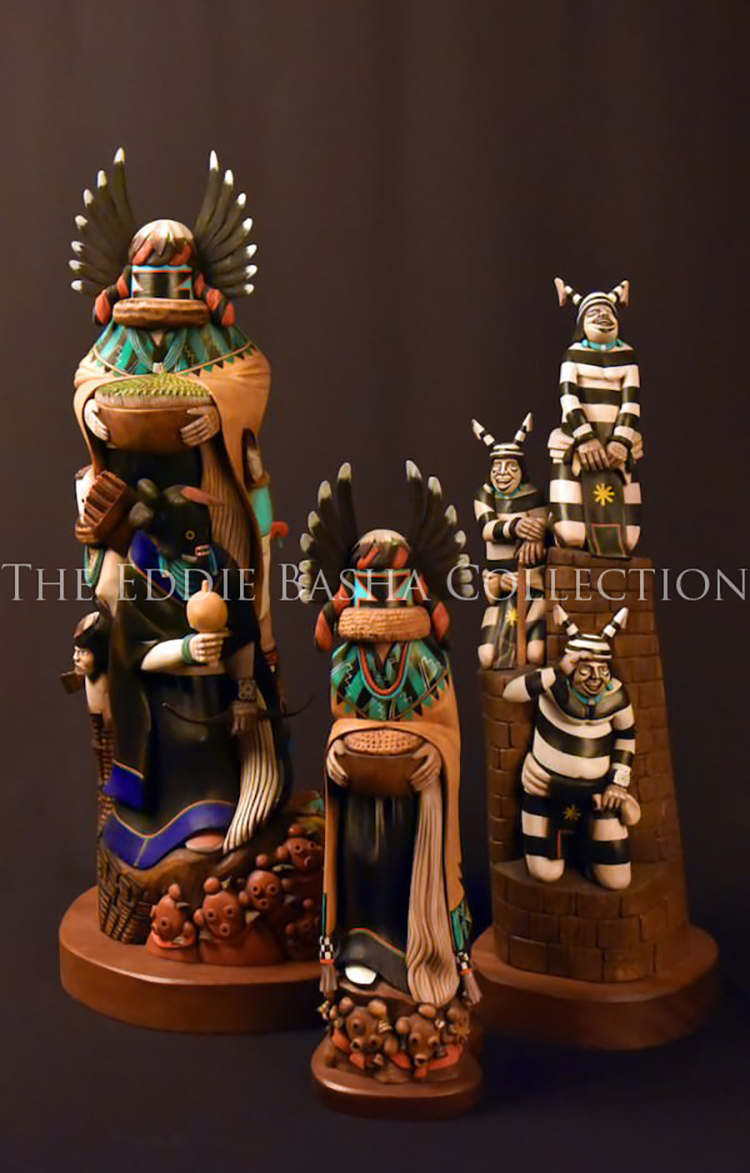
Katsinas
Artist: Wilmer Kaye (b.1952)
katsina
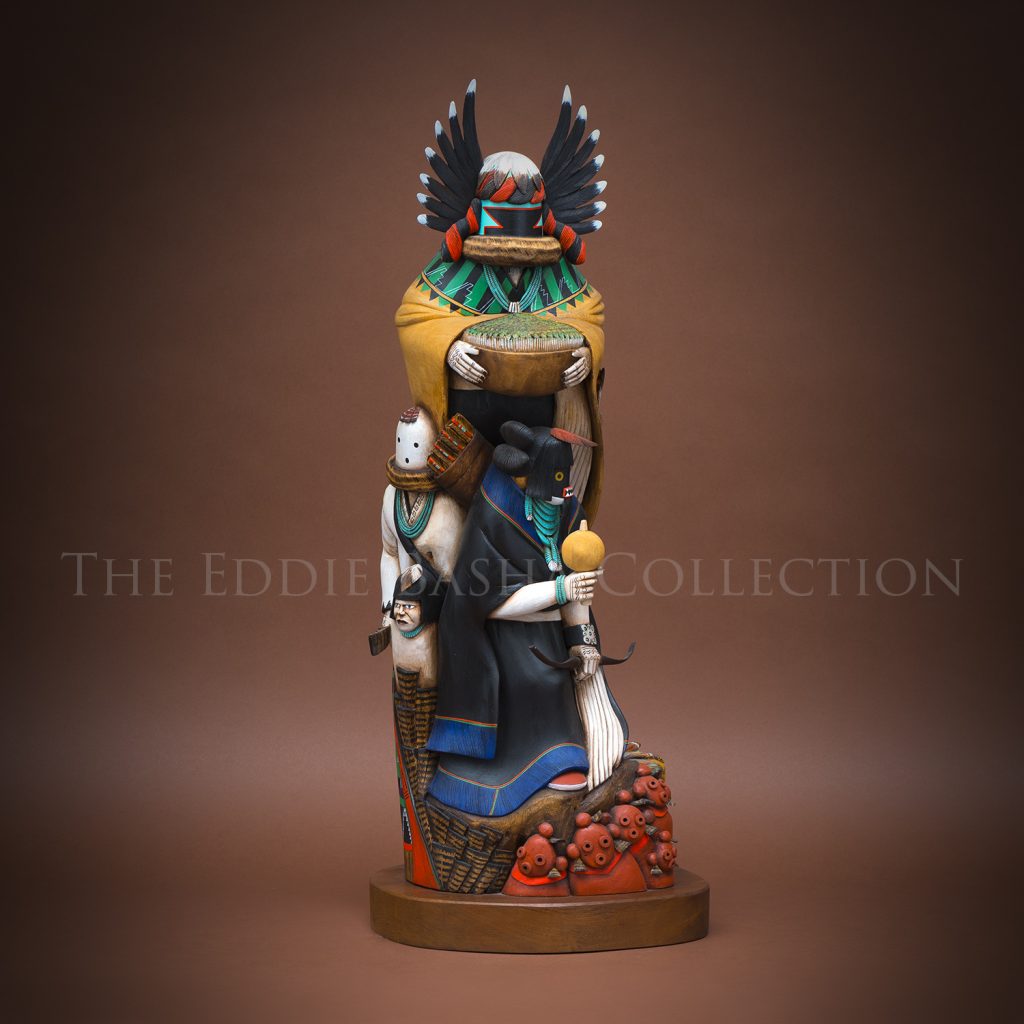 Cottonwood Tree Root (1996) | Dimensions: 30”h x 12”w x 12”d
Cottonwood Tree Root (1996) | Dimensions: 30”h x 12”w x 12”dFebruary is the Hopi lunar month of Powamuya in which one of the most important cultural events occurs, the sixteen-day Bean Dance Ceremonial. Kiva-germinated bean sprouts are distributed to villagers throughout by participating katsinam. And though the Ogre katsina threaten the children for misbehavior, they do so in a humorous way; gifts are also handed out to them.
This Bean Dance Katsina is an expressive representation of the activities and participants of this all important ceremony. It was exhibited by the artist, Wilmer Kaye, at the 1996 Santa Fe Indian Market and purchased by Eddie Basha for the collection at that time.
Bean Dance Katsina
Artist: Wilmer Kaye (b.1952)
Description:
Cottonwood Tree Root (1996) | Dimensions: 30”h x 12”w x 12”d
February is the Hopi lunar month of Powamuya in which one of the most important cultural events occurs, the sixteen-day Bean Dance Ceremonial. Kiva-germinated bean sprouts are distributed to villagers throughout by participating katsinam. And though the Ogre katsina threaten the children for misbehavior, they do so in a humorous way; gifts are also handed out to them.
This Bean Dance Katsina is an expressive representation of the activities and participants of this all important ceremony. It was exhibited by the artist, Wilmer Kaye, at the 1996 Santa Fe Indian Market and purchased by Eddie Basha for the collection at that time.
katsinaFebruary is the Hopi lunar month of Powamuya in which one of the most important cultural events occurs, the sixteen-day Bean Dance Ceremonial. Kiva-germinated bean sprouts are distributed to villagers throughout by participating katsinam. And though the Ogre katsina threaten the children for misbehavior, they do so in a humorous way; gifts are also handed out to them.
This Bean Dance Katsina is an expressive representation of the activities and participants of this all important ceremony. It was exhibited by the artist, Wilmer Kaye, at the 1996 Santa Fe Indian Market and purchased by Eddie Basha for the collection at that time.
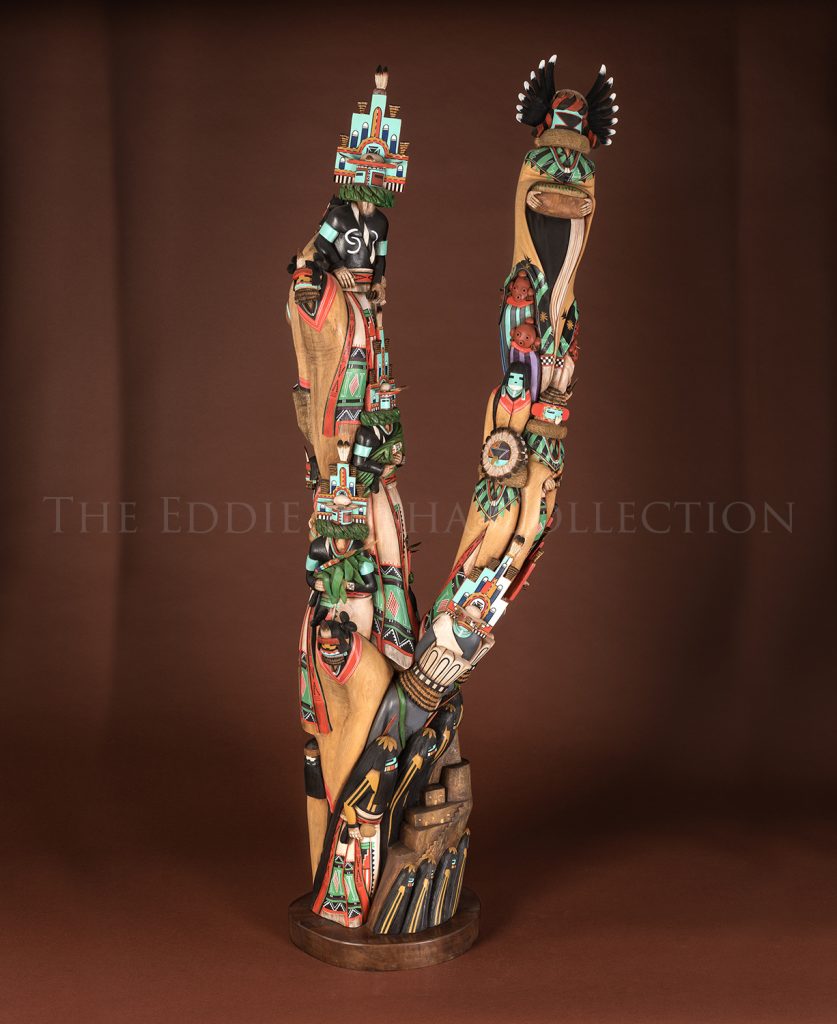 Cottonwood Tree Root (1995) | Dimensions: 55”h x 20”w x 17”d
Cottonwood Tree Root (1995) | Dimensions: 55”h x 20”w x 17”d Wilmer Kaye is well known for carving more sculptural dolls rather than fully detailed ones such as the one revealed here. Standing 55” tall and carved from the root of the cottonwood tree, this 1995 Best of Show Santa Fe Indian Market award winner, “Salako and Crow Mother,” with thirty-nine katsinas is a harmonious dance of grace, elegance and sophistication. Katsinam appear to rise from the kiva at the base and culminate with Salako, the Hopi Cloud Man, and Crow Mother, a figure of great dignity, two of the most beautiful and best known of all Hopi katsinas, at its two peaks. And between there are Mudheads, Long Hairs, Hano Manas, and more.
At thirteen years old, Wilmer’s apprenticeship began while watching his uncle Willard Loloma and others carve. After high school, Willard worked construction while he perfected his craft. Nowadays, he’s up with the sun and frequently spends his entire day carving. Throughout his career, Wilmer has won numerous honors and awards and has contributed to the advancement of katsina doll carving into the upper echelons of fine art. And he has done so in the good company of other talented, celebrated and award-winning relatives such as his sister, Verma Nequatewa, “Sonwai,” and their uncle, Charles Loloma, two of the most innovative Hopi jewelers.
Salako & Crow Mother
Artist: Wilmer Kaye (b.1952)
Description:
Cottonwood Tree Root (1995) | Dimensions: 55”h x 20”w x 17”d
Wilmer Kaye is well known for carving more sculptural dolls rather than fully detailed ones such as the one revealed here. Standing 55” tall and carved from the root of the cottonwood tree, this 1995 Best of Show Santa Fe Indian Market award winner, “Salako and Crow Mother,” with thirty-nine katsinas is a harmonious dance of grace, elegance and sophistication. Katsinam appear to rise from the kiva at the base and culminate with Salako, the Hopi Cloud Man, and Crow Mother, a figure of great dignity, two of the most beautiful and best known of all Hopi katsinas, at its two peaks. And between there are Mudheads, Long Hairs, Hano Manas, and more.
At thirteen years old, Wilmer’s apprenticeship began while watching his uncle Willard Loloma and others carve. After high school, Willard worked construction while he perfected his craft. Nowadays, he’s up with the sun and frequently spends his entire day carving. Throughout his career, Wilmer has won numerous honors and awards and has contributed to the advancement of katsina doll carving into the upper echelons of fine art. And he has done so in the good company of other talented, celebrated and award-winning relatives such as his sister, Verma Nequatewa, “Sonwai,” and their uncle, Charles Loloma, two of the most innovative Hopi jewelers.
katsinaWilmer Kaye is well known for carving more sculptural dolls rather than fully detailed ones such as the one revealed here. Standing 55” tall and carved from the root of the cottonwood tree, this 1995 Best of Show Santa Fe Indian Market award winner, “Salako and Crow Mother,” with thirty-nine katsinas is a harmonious dance of grace, elegance and sophistication. Katsinam appear to rise from the kiva at the base and culminate with Salako, the Hopi Cloud Man, and Crow Mother, a figure of great dignity, two of the most beautiful and best known of all Hopi katsinas, at its two peaks. And between there are Mudheads, Long Hairs, Hano Manas, and more.
At thirteen years old, Wilmer’s apprenticeship began while watching his uncle Willard Loloma and others carve. After high school, Willard worked construction while he perfected his craft. Nowadays, he’s up with the sun and frequently spends his entire day carving. Throughout his career, Wilmer has won numerous honors and awards and has contributed to the advancement of katsina doll carving into the upper echelons of fine art. And he has done so in the good company of other talented, celebrated and award-winning relatives such as his sister, Verma Nequatewa, “Sonwai,” and their uncle, Charles Loloma, two of the most innovative Hopi jewelers.
